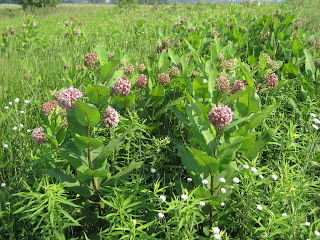Saturday was a good day at Forest Hill for a hike with my dog, Remi. The late morning weather was clear with a temperature of 82 degrees and a light wind out of the northwest. Instead of taking my usual hike around the Nature Area, I walked directly up to Reflection Hill to repeat an observation exercise that I did back in March. My task was to move quietly around the circular path on the top of Reflection Hill with my binoculars in hand, pausing for a few minutes in each direction to take in the sights and sounds. Starting on the north side, I saw a single Morning Dove fly overhead. Also, I noticed on the hillside lots of Queen Anne’s Lace as well as some Yellow and White Sweet Clover. Also, there was an over abundance of Autumn Olive bushes. I was amazed how quickly they had spread. Looking beyond, I noticed the water in Mallard Marsh could not be seen because of the dense growth of Cattails and Reed Canary Grass. Walking counterclockwise down the trail, I saw patches of Canadian Thistle, Brome Grass and a beautiful Banded-Wing Dragonlet. A shrieking Green Heron flew over my head from east to west. Gazing off to the west, I could just make out the tops of the benches on Artist Overlook. My view of Succession Field was totally obstructed by the dense thicket surrounding Willow Wallow. Also, I heard the song of a Yellowthroat coming from the willows. Continuing around the top of the hill, I noticed lots of seed heads of Timothy Grass, Orchard Grass, Rye Grass and Red Fescue next to the trail. Gazing south, my far off view of Brady Cemetery was blocked by two large Cottonwood trees in Frog Fen. Continuing along, I observed some small Yellow and Orange Hawkweed plants as well as Red and White Clover growing on the trail. Gazing east onto Grebe Pond, I observed a dozen Geese, a half dozen Mallards, a pair of Grebes, and several swooping Tree Swallows. On the north shore, a Great Blue Heron stood still and then took off and flew south over the water that was almost completely covered with green pondweed and algae. Looking over at the dock, it appeared the water level had dropped about a foot since last spring. Further away, Native Meadow had a whitish hue from the abundant growth of Queen Anne’s Lace along with large patches of yellow from the Black-eyed Susan’s. Also, lots of young Tree Swallows were perched on the power line above the meadow. Following the path back to the starting point, I noticed a few Chicory and Milkweed plants. I looked closely at the Milkweed for Monarch Caterpillars but was unable to find any. Finally, descending the hill, I headed back to the van and took off for home. Driving south on Rich Rd., I recalled being surprised the other day to see a Coyote standing in our neighbor’s bean field south of Adams Rd.
It is a sultry day; the sun has drunk
The dew that lay upon the morning grass;
There is no rustling in the lofty elm
That canopies my dwelling, and its shade
Scarce cools me. All is silent, save the faint
And interrupted murmur of the bee,
Settling on the sick flowers,
And then again, instantly on the wing.
William Cullen Bryant




